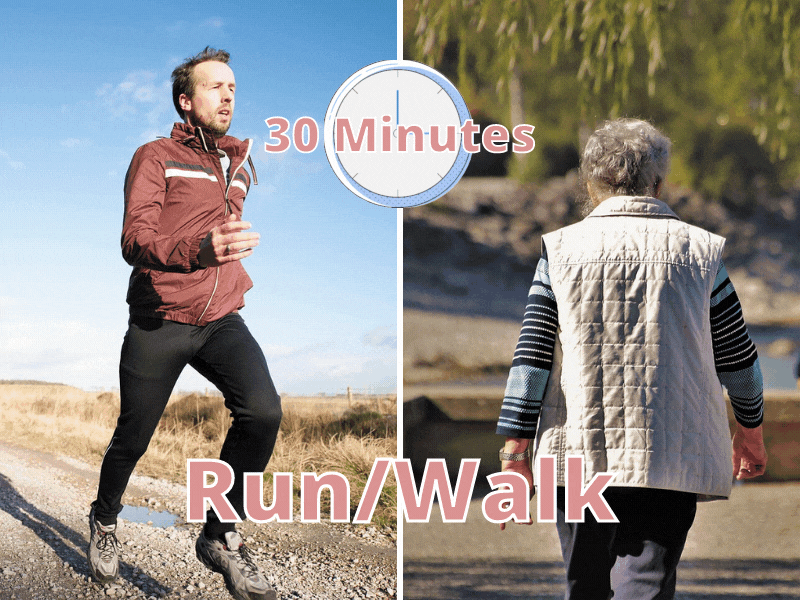To run/walk is something I usually do several times each week. I often will run, take a break and walk, then run again. Sometimes I just run for 5 or 20 minutes and walk the rest of the time. It depends on how I’m feeling.
A run/walk for 30 minutes is a great way to get in your exercise for the day. It helps you exercise at whatever level you’re at and benefit from both types of exercises. Walk or run as much as you want and when the 30 minutes is up, you’ve got your 30 minutes of exercise for the day.
When I go for a run, I usually like to run as much as possible. If the trail or road has steep inclines I might walk more often. Are you getting the benefits of both walking and running? Both can have a great influence on your health.

Walking for 30 Minutes

Walking for 30 minutes is a great way to exercise each day. You can go with a friend or get out by yourself and unwind. Walking is different from running but has most of the same benefits, so some people may prefer walking over running.
When I walk I find that my mood improves and I feel more energetic. Walking is enjoyable when I can get out at night and de-stress from the day.
Walking is a very low impact exercise, so the likelihood of injury is very low. That’s why many people choose this exercise overrunning since running injuries occur quite often.
The benefits of walking can be long-lasting and can give you immediate benefits each day. What are the benefits you could use from this type of exercise shown below?
Immediate Benefits
- Better mood
- Warms up the body
- Time to think
- Help with digestive system
- De-stresser
Long term Benefits
- Heart health
- More muscle – faster metabolism
- Stronger bones
- Can help with joint pain
- Sleep improvement after about 4 months
- Live longer
- Weight control
Running for 30 Minutes

I usually aim for about 30 or more minutes of exercise about 5 days a week. About 3 days a week I like to run.
I take the approach that I want to run for 30 minutes if my body is up to the task. That means I am regularly monitoring my body for how I feel and when I need to slow down.
I’ve seen the benefits of increasingly more energy and improved mood when I run regularly. And while my goals to run are important, I don’t try to push too hard because I know that injury is a risk that runners face more than walkers.
Running is like walking but gives you benefits faster. While runners get injured more, that doesn’t have to be you. Taking a gentle approach can give many years of running without injury.
Those that try to push too hard too fast are the ones that regularly get injured. Running will give you the most benefits if you can take slow progressive steps towards running for longer periods.
If you’re preparing for a marathon, take a longer time period to prepare. It’s not about the finish line, it’s about the long journey to a healthier life. Going slow and taking time for recovery is key.
Below are some of the benefits you’ll find with a consistent routine of running.
Immediate Benefits
- Better mood
- Blood circulation
- Thinking clearer
- Help move things along in the bowels
- De-stresser
- Sleep aid
- Runners high for some
Long term Benefits
- Heart health
- More muscle – faster metabolism
- Stronger bones
- Tend to be thinner
- Can help with joint pain
- Sleep improvement
- Live longer
- Prevent disease
- Boost immune system
How is Run/Walk Different?

When you run/walk, you’re splitting your time between running and walking during your exercise. This is normal to do for those running long distances, but you can also make it a practice in your exercise routine.
When you run, it can help and at the same time cause problems with your body. That’s why running slowly or run/walking is a great way to build up or reduce the stress levels your body is put under.
Run/walking is one way to help people transition from walking to a higher intensity exercise. Walking will allow your body to get your different body systems to function better but running will work even faster.
For those who can walk for 30 minutes 5-7 days a week, their health will be impacted greatly over the course of their life. Walking and diet can help some lead a very healthy life, but higher intensity exercise can get faster results.
Benefits
More benefits will come as you run/walk. Your muscles and heart will be working harder, increasing your ability to burn fat along with a healthy diet.
The main benefit of running over walking is the level of exercise your heart is receiving. As the heart gets stronger, it can pump blood more effectively and helps everything move better so that the cells can function at their full potential.
As your body moves things better, it can start to get rid of the bad items in your body more effectively and reinforce the good items. Your cell will be getting more oxygen and nutrients when running.
Warnings
If you are slowly progressing with the intensity of your exercise over the course of weeks and months, you will likely show improvements in your health without the risk of injury.
Some people want to push too much and put too much strain on their bodies. This leads to injury and may lower their immune response. Any exercise that puts a lot of stress on the body requires recovery time.
That’s what’s great about run/walking; you can monitor yourself and just put in a little more effort each week so that injury is not a problem.
You can also tell yourself it’s OK to stop and walk at any time when your body says to slow down. The goal is not to add too much stress, but just enough to improve steadily.
How Should I Divide a 30 Minute Run/Walk?

Running can be fun and walking can be relaxing, so combining the two can be the best of both worlds. To determine how much you should walk vs run, make sure you can walk for 30 minutes without any problems.
I think spending the same amount of time each week walking and increasing the time by 5 minutes in the next few weeks will help individuals to reach their goal of 30 minutes of walking each week.
Here’s a chart for those working toward 30 minutes of walking each day, 3-5 times a week. Always consult your doctor before starting any exercise program, especially if you have any medical conditions.
Walking Chart
|
Walk |
Day 1 |
Day 2 |
Day 3 |
Day 4 |
Day 5 |
|---|---|---|---|---|---|
|
Week 1 |
5 Min |
5 Min |
5 Min |
5 Min |
5 Min |
|
Week 2 |
10 Min |
10 Min |
10 Min |
10 Min |
10 Min |
|
Week 3 |
15 Min |
15 Min |
15 Min |
15 Min |
15 Min |
|
Week 4 |
20 Min |
20 Min |
20 Min |
20 Min |
20 Min |
|
Week 5 |
25 Min |
25 Min |
25 Min |
25 Min |
25 Min |
|
Week 6 |
30 Min |
30 Min |
30 Min |
30 Min |
30 Min |
For those who can walk for 30 minutes, and are ready to start challenging themselves with walk running, try adding 5 minutes of running for about 3 weeks before adding more time if desired. The goal should be to add just enough to improve without causing too much stress on the body.
Here’s a chart to use when starting to run/walk and the time periods to try out. Remember to only run about 2-3 days a week to ensure your body has time to recover. Adjust the schedule to your needs.
Run/Walk Chart
| Run/Walk | Day 1 | Day 2 | Day 3 |
|---|---|---|---|
| Weeks 1-3 |
25/5 Run/Walk |
25/5 Run/Walk |
25/5 Run/Walk |
| Weeks 4-6 |
20/10 Run/Walk |
20/10 Run/Walk |
20/10 Run/Walk |
| Weeks 7-9 |
15/15 Run/Walk |
15/15 Run/Walk |
15/15 Run/Walk |
| Weeks 10-12 |
10/20 Run/Walk |
10/20 Run/Walk |
10/20 Run/Walk |
| Weeks 13-15 |
5/25 Run/Walk |
5/25 Run/Walk |
5/25 Run/Walk |
Committing to Your Health

You don’t have a be healthy to get started. Just committing to show up is probably the most important part. The rest will follow if you just show up.
The best exercise program starts with a commitment to get out and make an effort each day you’ve set a goal to exercise. Committing is the most important part.
Consistently trying will give you more strength. Going out for a week and pushing yourself to do some intense exercise that doesn’t persist in the following weeks isn’t helping much.
If you need to, go out each time you’ve scheduled and just show up, even if you don’t exercise. The routine and commitment will pay off over time. If you need to extend the time period to transition to run/walk to longer, then do that.
Your gentle transition to running and walking will enable you to more easily commit to your exercise program without getting burnt out.
We’ve got busy lives, emotional lives, and just walking a bit can help, without the need to stress about getting to the gym or changing clothes. Try it and see how you feel after a month.
You can add years to your life and improve your overall well-being by getting out and starting a run/walk routine.
Thanks for visiting Helpshoe.com
Related Questions
Should I walk in sandals?
Walking for short distances in sandals should be fine, but depending on your foot and the sandals, you’ll end up causing problems with your feet when walking long distances with sandals. Many sandals can’t support and don’t allow for the arch to get stronger, so walking shoes will better support over distances.
How to start walking more?
Wear your walking shoes to work. During a break, time walk for 5-10 minutes around the block or complex. You can also get a standing desk. Start walking up the stairs. Park away from your destinations. Take the dog out twice. Get a partner to help you stay accountable.

